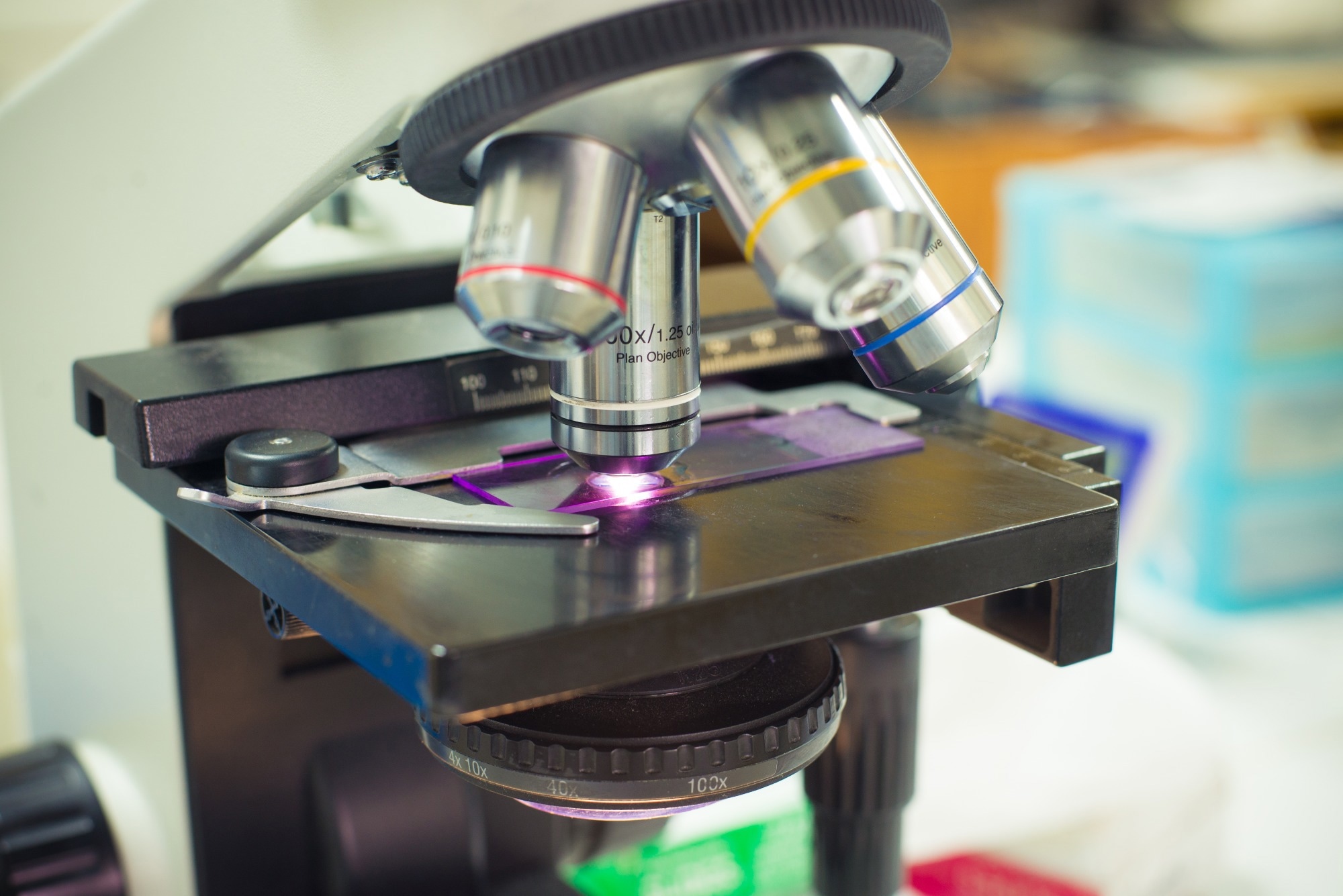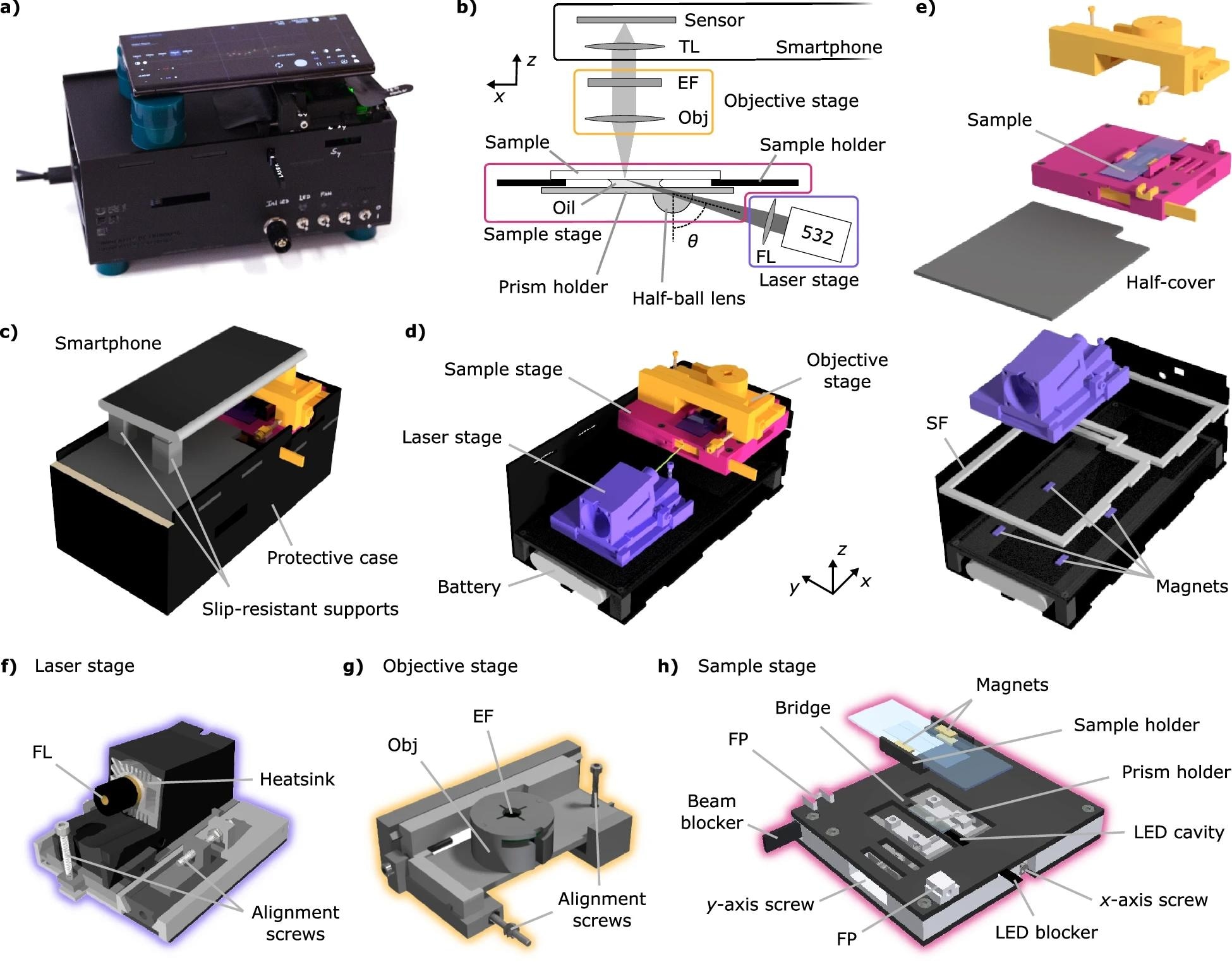 By Pooja Toshniwal PahariaReviewed by Lauren HardakerOct 15 2025
By Pooja Toshniwal PahariaReviewed by Lauren HardakerOct 15 2025In a recent study published in Nature Communications, researchers developed a €350 smartphone-based microscope that can detect individual molecules. This brings super-resolution, research-grade imaging capabilities to the palm of a hand.
 Image credit: S.Toey/Shutterstock.com
Image credit: S.Toey/Shutterstock.com
Weighing just 1.2 kg, it achieves a localization precision of 84 nm, corresponding to a 6.6-fold improvement in resolution over diffraction-limited imaging, without signal amplification. Mass-produced smartphone cameras enable single-molecule ribonucleic acid (RNA) assays, making high-sensitivity diagnostics, field research, and molecular education more accessible than ever.
The rapid evolution of smartphone technology, driven by mass production, advanced imaging sensors, and powerful computing capabilities, has transformed smartphones into versatile tools for biomedical and environmental applications. Mobile device-based fluorescence microscopy has already enabled clinic-based testing, immunoassay quantification, bacterial detection, and tissue imaging at a fraction of traditional costs.
Research efforts have focused on achieving single-molecule-level sensitivity to unlock ultra-sensitive bioassays and portable super-resolution imaging. However, previous smartphone-based systems required complex amplification mechanisms, costly optical components, or controlled laboratory setups, limiting their accessibility and practicality.
This study demonstrates that direct single-molecule detection is achievable using commercially available smartphones combined with a simple optical configuration. This eliminates the need for a fluorescence signal or molecular amplification while maintaining low cost and portability.
About the Study
In the present study, researchers designed and validated a low-cost, portable, and user-friendly mobile-based microscope to detect a single fluorescent molecule without requiring signal amplification. The setup aimed to overcome the previous limitations of cost, complexity, and dependence on specialized laboratory infrastructure, making single-molecule bioassays and super-resolution microscopy more accessible for educational and on-site applications.
The team tested the system using three smartphones (Samsung Galaxy S22 Ultra, iPhone 14 Pro, and Huawei P20 Pro). They used the built-in complementary metal-oxide-semiconductor (CMOS) sensors for fluorescence detection. The microscope’s optical configuration relies on a 532 nm laser beam focused through a semi-spherical prism to achieve total internal reflection (TIR).
A low-aperture lens captured the fluorescence, filtered it through colored glass, and focused it onto the smartphone camera, which acted as the tube lens. The laser stage, an objective stage, and a sample stage are enclosed in a protective case that ensures laser safety and compatibility with various smartphone models. The magnets and alignment screws enable easy component exchange and precise optical alignment without reconfiguration. While compact and user-friendly, the setup still employs a laser-based excitation path rather than simple LED illumination, requiring basic handling precautions.
To evaluate single-molecule sensitivity, the researchers measured deoxyribonucleic acid (DNA) origami nanostructures labeled with ATTO 542 fluorophores and compared the results with those of a research-grade fluorescence microscope. They calculated the signal-to-background ratio (SBR) and signal-to-noise ratio (SNR) from fluorescence transients in raw image data.
The team further implemented DNA-Points Accumulation for Imaging in Nanoscale Topography (DNA-PAINT) to achieve single-molecule localization microscopy (SMLM) and super-resolution imaging of cellular microtubule networks and DNA origami constructs. Finally, they developed a DNA-origami-based bioassay to detect Ebola RNA fragments to demonstrate diagnostic potential, confirming the system’s viability for molecular sensing in point-of-care (POC) settings.
 Smartphone-based fluorescence microscope
Smartphone-based fluorescence microscope
Results
The portable mobile platform-based microscope directly detected fluorescent single molecules without signal amplification, as confirmed through DNA origami experiments, which showed a favorable SNR (3.3) for diagnostic applications. Distinct single-step photobleaching and binary blinking patterns, hallmarks of single fluorophores, validated its detection sensitivity. The results establish the device as a practical and accessible platform for single-molecule assays.
Using DNA-PAINT, the microscope achieved super-resolution imaging through SMLfM, successfully resolving DNA origami assemblies and cellular microtubule networks. The system could localize with an average precision of 84 nm, improving resolution approximately 6.6-fold, compared with diffraction-limited images, and closely matched measurements obtained with high-end laboratory microscopes. The mean distance between docking sites in DNA origami (260 nm) closely aligned with those measured using professional instruments (248 nm), underscoring the device’s accuracy and reliability.
In the DNA origami bioassays conducted to assess the diagnostic potential, the structures displayed two fluorescent spots in controls and three in target RNA, confirming successful detection of Ebola RNA fragments. The mobile device-based microscope identified the RNA in 50% of origami sensors, compared with 66% for high-end microscopes, a strong performance given the cost and portability advantages.
The prism-coupled TIR laser excitation and raw RGB data analysis optimized fluorescence detection by isolating the most responsive camera channels. These factors were key to achieving high contrast and precision. Operating with an estimated cost below €350 and weighing only 1.2 kg, the microscope delivered super-resolution imaging and single-molecule assays on a standard desk without needing optical tables or specialized expertise.
Conclusions
The study presents a low-cost, portable mobile device-based microscope for attaining direct single-molecule detection and super-resolution imaging, advancing the democratization of high-sensitivity fluorescence microscopy. Using standard smartphone sensors enables DNA-origami and RNA biosensing assays with research-grade precision, anytime, anywhere. Its connectivity and scalability open opportunities for AI-assisted, decentralized diagnostics and real-time data sharing.
Future improvements could focus on increasing photon collection efficiency, imaging speed, and on-device data processing through dedicated smartphone applications to extend the use to personalized medicine, digital bioassays, and global-level STEM and life sciences education. This innovation brings molecular-scale imaging to the fingertips, empowering science far beyond traditional laboratories.
Journal Reference
Loretan, M., Barella, M., Fuchs, N. et al. (2025). Direct single-molecule detection and super-resolution imaging with a low-cost portable smartphone-based microscope. Nat Commun, 16, 8937. DOI: 10.1038/s41467-025-63993-z. https://www.nature.com/articles/s41467-025-63993-z